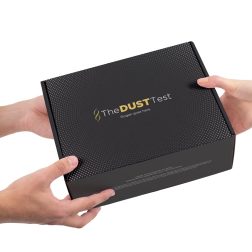No products in the cart.
Mold Resources
What is Alternaria Mold?
Alternaria is a type of mold that includes species that live in soil and air, as well as those that can cause diseases in plants. Some species of Alternaria mold feed on dead or decaying organic matter, while others can infect and harm plants.
What Does Alternaria Mold Look Like?
Alternaria is a fast-growing mold that typically appears as dark spots or patches, ranging from black and dark brown to gray. These patches often have a velvety or fuzzy texture. On plants, Alternaria might look like small, dark lesions or spots on leaves, stems, or fruits. Indoors, you might find it growing on damp surfaces like walls, ceilings, carpets, and textiles. If you notice any of these dark, fuzzy spots in areas with high moisture, there's a good chance it could be Alternaria mold.
What Conditions Does it Grow Best In?
Alternaria is primarily an outdoor mold. Depending on the species, it can grow on dead or decaying organic matter or on living plants. However, its spores can and do often find their way into homes and can cause issues once they’ve passed indoors. Alternaria typically produces the most spores in warm, dry air, meaning that in temperate climates, it produces the highest number of spores during the summer. Outdoor spore counts tend to correlate directly to increased indoor spore counts.
Alternaria spores that enter the home can be found in a wide range of locations including drywall, ceiling tiles, carpet, wallpaper, wood, textiles, window frames, and within components of an HVAC system. Alternaria requires very little moisture to grow and, much like other molds, once it’s in your home, it can begin to propagate, given the proper conditions, by feeding on organic compounds found in many common building materials.
Is Alternaria Mold Dangerous?
Alternaria mold represents a risk factor for asthma and allergic rhinitis. Severe asthma and acute, potentially life-threatening aggravations for asthma sufferers have been noted.
Furthermore, mold colonies release microscopic particles into the air, including fragments, spores, endotoxins, and exotoxins. Some species of Alternaria also release microscopic toxins called mycotoxins when threatened. The longer the growth goes on, the more particles it will release. This lowers the indoor air quality and can cause unwanted exposure as those particles enter the body through inhalation.
Exposure triggers a multi-systemic immune response, so symptoms can span the entire body. Some common symptoms include headaches, coughing, runny nose, watery eyes, rashes, mood swings, digestive issues, brain fog, chronic fatigue, and more. Everyone responds differently to mold exposure for a variety of factors. While one person may have no symptoms, another may develop over a dozen. That’s why all microbial growth, including pink mold (or bacteria), should be handled quickly and correctly.
How to Minimize the Impact of Alternaria Mold in Our Homes?
The most basic step is regular cleaning. The spores that cause negative health effects will settle into dust and become trapped there. Removing the dust removes the spores. Limiting the moisture conditions in your home can also discourage growth and help manage Alternaria mold spores before a source forms indoors.
Also, work on filtering particles, like Alternaria spores, from your air using the highest-rated MERV filters the unit can handle and air purifiers.
What to Do If You Suspect Alternaria Mold
Your first step will be to test the dust within your home.
The Dust Test:
The Dust Test will help you know if there’s a problem before spending thousands of dollars trying to find one (both medically and in your home). And, if there is a problem, the data will indicate what you’re being exposed to before your inspector comes so that you can ensure they will find where it’s coming from.
Traditionally, inspectors conduct dust testing while they’re inside the home. By the time the results come back, though, they’re long gone and working for the next client. This can confuse you and wonder if they really "got it all" while collecting data. With The Dust Test, we help you identify the mold, bacteria, and biotoxins in the home that the inspector needs to find sources of. This data is crucial for successful remediation protocols because it provides the information needed to properly remove all sources of contamination from the home and ensure you and your family have a healthy environment that supports ongoing well-being.
The sooner you find and remediate the contamination, the less exposure you’ll face, and the less likely it is that another problem will develop elsewhere.
If you’re experiencing chronic symptoms, you should also contact a qualified medical professional familiar with helping clients who are dealing with environmental exposures so that they can help you on the path to healing.
Showing the single result
Still Have Questions?
A member of our team is here to help! Click on “Get Started ➤” below to book a consultation with a member of the HOMECLEANSE team. We have a few quick questions that will help us put together a roadmap to solve or prevent all of your mold problems.
Two minutes of your time could lead to better health for you and your family.

